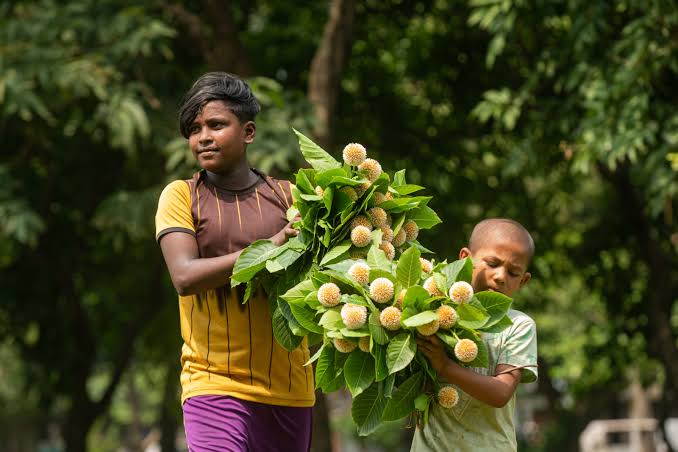Rajib Kanti Roy
Published:2025-06-29 02:04:37 BdST
Kadam: The emblematic blossom of the monsoon
With the arrival of Ashar, the first month of the monsoon in the Bengali calendar, the season ushers in steady rainfall, rivers brimming with water, abundant fish, and, of course, the distinctive bloom of the Kadam flower. Hanging in clusters nestled among green shrubbery, these golden blossoms create one of the most mesmerising scenes of the rainy season.
With its round blooms and sweet, earthy scent, the Kadam is an enduring symbol of the monsoon months – Ashar and Shrabon. The flower’s visual appeal is unmatchable, and beyond its beauty, the flower is deeply embedded in the region’s mythology, literature, and culture.
As the rainy season has a profound connection with the lives of the people of this region, the Kadam flower has been celebrated in Bengali literature for centuries. Love for the flower is evident across all literary genres. Works such as Shri Krishnakirtan by Baru Chandidas; numerous poems and songs by Rabindranath Tagore and Kazi Nazrul Islam; Polli Borsha by Jasim Uddin; Kadam Phuler Itibritto by Al Mahmud; Amon Borshar Dine by Shamsur Rahman; as well as novels, dramas, and songs by Humayun Ahmed, all testify to the flower’s deep-rooted importance in Bengali life.
Typically yellowish-orange in colour, the Kadam is globular, resembling the size and shape of a golf ball.
Each blossom is densely covered with pollen and surrounded by short, white filaments that give it a soft texture. Both nature lovers and pollinators are attracted by the appeal of its sweet scent. While the fragrance is most pleasant when the flower is freshly bloomed, it turns slightly pungent as the flower matures – a scent many are more familiar with.
During pollination, bees and other insects swarm the flowers, while later, birds such as bulbuls and black-hooded orioles feed on the ripened fruit.
There is some debate over the tree’s scientific classification. Scottish botanist William Roxburgh named it Nauclea cadamba, while it is also known by the botanical name Anthocephalus cadamba. In Bengali and Sanskrit, it goes by several names, including Brittopushpo, Neep, Surovi, Kornopurok, Bhringobollov, Monjukeshini, Prabissho, Shoshorpo, Shindhupushpo, and Pulki.
The origin of the tree also appears controversial, as some claim it came from Madagascar, but others say it was first found in warm areas of India and China.
Kadam trees are relatively easy to grow in Bangladesh’s climate and soil. They can reach heights of 150 feet with a strong, erect trunk and a broad, dense crown. Left untrimmed, its radial branches grow long and thick. The wood of the Kadam tree is used for various purposes, including for pulp, paper mills, plywood, boxes and crates, as it is not strong enough for making furniture or using in other works.
Beyond its aesthetic and commercial value, the Kadam tree has notable medicinal properties. According to scientific research, it carries a high concentration of phytochemicals and secondary metabolites with various pharmacological benefits. These compounds may serve as natural alternatives to synthetic drugs in the treatment of several chronic and difficult-to-cure diseases.
Not all areas of Dhaka are blessed with the blossoms of Kadam amid the rising pressure of urbanisation and deforestation. Yet the flower can still be found in Ramna Park, Botanical Garden, the Bangladesh Shilpakala Academy, and Bakshi Bazar.
The vibrant clusters of Kadam flowers adorning these trees resemble golden crowns on a sea of green, quietly reminding passersby of nature’s enduring elegance.
Unauthorized use or reproduction of The Finance Today content for commercial purposes is strictly prohibited.


